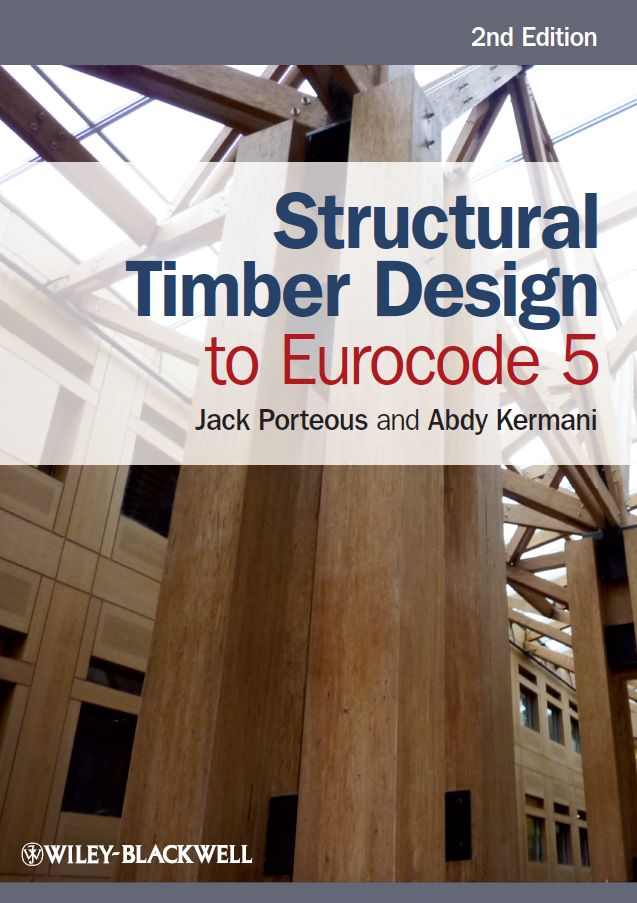

Contents
Preface to the Second Edition
Chapter 1: Timber as a Structural Material
1.1 INTRODUCTION
1.2 THE STRUCTURE OF TIMBER
1.3 TYPES OF TIMBER
1.4 NATURAL CHARACTERISTICS OF TIMBER
1.5 STRENGTH GRADING OF TIMBER
1.6 SECTION SIZES
1.7 ENGINEERED WOOD PRODUCTS (EWPs)
1.8 SUSPENDED TIMBER FLOORING
1.9 ADHESIVE BONDING OF TIMBER
1.10 PRESERVATIVE TREATMENT FOR TIMBER
1.11 FIRE SAFETY AND RESISTANCE
1.12 REFERENCES
Chapter 2: Introduction to Relevant Eurocodes
2.1 EUROCODES: GENERAL STRUCTURE
2.2 EUROCODE 0: BASIS OF STRUCTURAL DESIGN (EC0)
2.3 EUROCODE 5: DESIGN OF TIMBER STRUCTURES – PART 1-1: GENERAL – COMMON RULES AND RULES FOR BUILDINGS (EC5)
2.4 SYMBOLS
2.5 REFERENCES
Chapter 3: Using Mathcad® for Design Calculations
3.1 INTRODUCTION
3.2 WHAT IS Mathcad?
3.3 WHAT DOES Mathcad DO?
3.4 SUMMARY
3.5 REFERENCES
Chapter 4: Design of Members Subjected to Flexure
4.1 INTRODUCTION
4.2 DESIGN CONSIDERATIONS
4.3 DESIGN VALUE OF THE EFFECT OF ACTIONS
4.4 MEMBER SPAN
4.5 DESIGN FOR ULTIMATE LIMIT STATES (ULS)
4.6 DESIGN FOR SERVICEABILITY LIMIT STATES (SLS)
4.7 REFERENCES
4.8 EXAMPLES
Chapter 5: Design of Members and Walls Subjected to Axial or Combined Axial and Flexural Actions
5.1 INTRODUCTION
5.2 DESIGN CONSIDERATIONS
5.3 DESIGN OF MEMBERS SUBJECTED TO AXIAL ACTIONS
5.4 MEMBERS SUBJECTED TO COMBINED BENDING AND AXIAL LOADING
5.5 DESIGN OF STUD WALLS
5.6 REFERENCES
5.7 EXAMPLES
Chapter 6: Design of Glued-Laminated Members
6.1 INTRODUCTION
6.2 DESIGN CONSIDERATIONS
6.3 GENERAL
6.4 DESIGN OF GLUED-LAMINATED MEMBERS WITH TAPERED, CURVED OR PITCHED CURVED PROFILES (ALSO APPLICABLE TO LVL MEMBERS)
6.5 FINGER JOINTS
ANNEX 6.1
ANNEX 6.2
6.6 REFERENCES
6.7 EXAMPLES
Chapter 7: Design of Composite Timber and Wood-Based Sections
7.1 INTRODUCTION
7.2 DESIGN CONSIDERATIONS
7.3 DESIGN OF GLUED COMPOSITE SECTIONS
7.4 REFERENCES
7.5 EXAMPLES
Chapter 8: Design of Built-Up Columns
8.1 INTRODUCTION
8.2 DESIGN CONSIDERATIONS
8.3 GENERAL
8.4 BENDING STIFFNESS OF BUILT-UP COLUMNS
8.5 COMBINED AXIAL LOADING AND MOMENT
8.6 EFFECT OF CREEP AT THE ULS
8.7 REFERENCES
8.8 EXAMPLES
Chapter 9: Design of Stability Bracing, Floor and Wall Diaphragms
9.1 INTRODUCTION
9.2 DESIGN CONSIDERATIONS
9.3 LATERAL BRACING
9.4 FLOOR AND ROOF DIAPHRAGMS
9.5 THE IN-PLANE RACKING RESISTANCE OF TIMBER WALLS UNDER HORIZONTAL AND VERTICAL LOADING
9.6 REFERENCES
9.7 EXAMPLES
Chapter 10: Design of Metal Dowel-type Connections
10.1 INTRODUCTION
10.2 DESIGN CONSIDERATIONS
10.3 FAILURE THEORY AND STRENGTH EQUATIONS FOR LATERALLY LOADED CONNECTIONS FORMED USING METAL DOWEL FASTENERS
10.4 MULTIPLE DOWEL FASTENERS LOADED LATERALLY
10.5 DESIGN STRENGTH OF A LATERALLY LOADED METAL DOWEL CONNECTION
10.6 EXAMPLES OF THE DESIGN OF CONNECTIONS USING METAL DOWEL-TYPE FASTENERS
10.7 MULTIPLE SHEAR PLANE CONNECTIONS
10.8 AXIAL LOADING OF METAL DOWEL CONNECTION SYSTEMS
10.9 COMBINED LATERALLY AND AXIALLY LOADED METAL DOWEL CONNECTIONS
10.10 LATERAL STIFFNESS OF METAL DOWEL CONNECTIONS AT THE SLS AND ULS
10.11 FRAME ANALYSIS INCORPORATING THE EFFECT OF LATERAL MOVEMENT IN METAL DOWEL FASTENER CONNECTIONS
10.12 REFERENCES
10.13 EXAMPLES
Chapter 11: Design of Joints with Connectors
11.1 INTRODUCTION
11.2 DESIGN CONSIDERATIONS
11.3 TOOTHED-PLATE CONNECTORS
11.4 RING AND SHEAR-PLATE CONNECTORS
11.5 MULTIPLE SHEAR PLANE CONNECTIONS
11.6 BRITTLE FAILURE DUE TO CONNECTION FORCES AT AN ANGLE TO THE GRAIN
11.7 ALTERNATING FORCES IN CONNECTIONS
11.8 DESIGN STRENGTH OF A LATERALLY LOADED CONNECTION
11.9 STIFFNESS BEHAVIOUR OF TOOTHED-PLATE, RING AND SHEAR-PLATE CONNECTORS
11.10 FRAME ANALYSIS INCORPORATING THE EFFECT OF LATERAL MOVEMENT IN CONNECTIONS FORMED USING TOOTHED-PLATE, SPLIT-RING OR SHEAR-PLATE CONNECTORS
11.11 REFERENCES
11.12 EXAMPLES
Chapter 12: Moment Capacity of Connections Formed with Metal Dowel Fasteners or Connectors
12.1 INTRODUCTION
12.2 DESIGN CONSIDERATIONS
12.3 THE EFFECTIVE NUMBER OF FASTENERS IN A ROW IN A MOMENT CONNECTION
12.4 BRITTLE FAILURE
12.5 MOMENT BEHAVIOUR IN TIMBER CONNECTIONS: RIGID MODEL BEHAVIOUR
12.6 THE ANALYSIS OF STRUCTURES WITH SEMI-RIGID CONNECTIONS
12.7 REFERENCES
12.8 EXAMPLES
Chapter 13: Racking Design of Multi-storey Platform Framed Wall Construction
13.1 INTRODUCTION
13.2 CONCEPTUAL DESIGN
13.3 DESIGN REQUIREMENTS OF RACKING WALLS
13.4 LOADING
13.5 BASIS OF METHOD A
13.6 BASIS OF THE RACKING METHOD IN PD6693-1
13.7 REFERENCES
13.8 EXAMPLES
Appendix A: Weights of Building Materials
Appendix B: Related British Standards for Timber Engineering in Buildings
Appendix C: Possible Revisions to be Addressed in a Corrigendum to EN 1995-1-1:2004 + A1:2008
Index
The Example Worksheets Order Form
To Margaret and John
Dawn and Romi

© Jack Porteous and Abdy Kermani 2013
Published 2013 by Blackwell Publishing Ltd.
First edition published 2007 by Blackwell Publishing
Registered Office
John Wiley & Sons, Ltd, The Atrium, Southern Gate, Chichester, West Sussex, PO19 8SQ, United Kingdom.
Editorial Offices
9600 Garsington Road, Oxford, OX4 2DQ, United Kingdom.
The Atrium, Southern Gate, Chichester, West Sussex, PO19 8SQ, United Kingdom.
For details of our global editorial offices, for customer services and for information about how to apply for permission to reuse the copyright material in this book please see our website at www.wiley.com/wiley-blackwell.
The right of the author to be identified as the author of this work has been asserted in accordance with the UK Copyright, Designs and Patents Act 1988.
All rights reserved. No part of this publication may be reproduced, stored in a retrieval system, or transmitted, in any form or by any means, electronic, mechanical, photocopying, recording or otherwise, except as permitted by the UK Copyright, Designs and Patents Act 1988, without the prior permission of the publisher.
Designations used by companies to distinguish their products are often claimed as trademarks. All brand names and product names used in this book are trade names, service marks, trademarks or registered trademarks of their respective owners. The publisher is not associated with any product or vendor mentioned in this book.
Limit of Liability/Disclaimer of Warranty: While the publisher and author(s) have used their best efforts in preparing this book, they make no representations or warranties with respect to the accuracy or completeness of the contents of this book and specifically disclaim any implied warranties of merchantability or fitness for a particular purpose. It is sold on the understanding that the publisher is not engaged in rendering professional services and neither the publisher nor the author shall be liable for damages arising herefrom. If professional advice or other expert assistance is required, the services of a competent professional should be sought.
Library of Congress Cataloging-in-Publication Data
Porteous, Jack.
Structural timber design to Eurocode 5 / Jack Porteous and Abdy Kermani. – 2nd edition.
pages cm
Includes bibliographical references and index.
ISBN 978-0-470-67500-7 (pbk.)
1. Building, Wooden–Standards–Europe. 2. Structural frames–Design and construction–Standards–Europe. 3. Timber–Standards–Europe. I. Kermani, Abdy. II. Title.
TA666.P66 2013
694.02′184–dc23
2012051136
A catalogue record for this book is available from the British Library.
Wiley also publishes its books in a variety of electronic formats. Some content that appears in print may not be available in electronic books.
Cover design by Sandra Heath
As a natural material, timber is unique, innovative and easy to handle. It is sustainable, environmentally friendly, can be readily recycled and as sawn sections or quality controlled engineered products, timber has a large potential market for use as a structural and building material. However, the existing civil and structural engineering curricula neglect, to a large extent, the importance of timber as a viable engineering material and as a consequence relatively few textbooks provide information on the design of timber structures. Also, most books have tended to concentrate on designs in accordance with BS 5268, a permissible stress based design, with limited information on designs to Eurocode 5, which is based on a limit states design philosophy.
However, on 31 March 2010 the structural design code used for timber, BS 5268, was withdrawn and is now replaced by Eurocode 5 and from 2015 all timber designs in the UK will have to be carried out in accordance with this code. This book is based solely on the use of Eurocode 5: Design of structures – Part 1-1: General – Common Rules and Rules for Building, referred to as EC5 in the book, and incorporates the requirements of the associated UK National Annex. There is a pressing need for practising engineers as well as specialist contractors, postgraduate and undergraduate students of civil and structural engineering courses to become familiar with the design rules in EC5 and this book offers a detailed explanation and guide to the use of the code. It provides comprehensive information and a step-by-step approach to the design of elements, connections and structures using numerous worked examples and encourages the use of computers to carry out design calculations.
The version of EC5 covered in the first edition of the book was revised in 2008 (BS EN: 1995-1-1:2004 + A1:2008) and any changes that are relevant to the book content have been taken into account in this edition. The UK NA to BS EN 1995-1-1 was also revised in 2012 and this book makes reference to the current issue, NA to BS EN 1995-1-1:2004 + A1:2008, Incorporating National Amendment No. 2. The first issue of non-contradictory complementary information relating to EC5 was finalised in 2012 and published in PD6693-1 and where the content of this document is considered to be of relevance to an issue covered in the book, reference has been made to it in the relevant chapter. Further, a corrigendum relating to the above version of EC5 is about to be issued to address errors in some of the code clauses and also provide some clarification on the implementation of some of the existing clause requirements. In anticipation of the publication of the corrigendum, those matters of relevance to the content of the book have also been taken into account in this edition. New content has been added to the text, covering cases where composite sections are subjected to combined axial and bending stresses, a new chapter has been added covering racking design of wall diaphragms and the opportunity has been taken to correct any areas of possible misinterpretation of the code, minor presentation and typographical errors in the previous edition.
Chapter One introduces the nature and inherent characteristics of timber and gives an overview of timber and its engineered products as structural and building materials, and includes design related information on the strength and stiffness properties required for design in accordance with the requirements of EC5. In Chapter Two the design philosophy used in Eurocodes is explained. It includes information on the relevance of the requirements of Eurocode 0 to EC5 as well as the significance of the effects of moisture content, load duration, creep behaviour and size factors etc., in the design process.
Chapter Three gives an overview of Mathcad®, a computer software used to carry out mathematical calculations, and details its simplicity and the advantages that it provides when used for design calculations. The software is commonly used in design offices and universities and the aim is to encourage readers to use computing as a tool to increase their understanding of how design solutions vary in response to a change in one or more of the variables and how alternative design options can be easily investigated. The design of basic elements is explained and illustrated in Chapters Four and Five, whilst the design of more specialised elements such as glued-laminated straight, tapered and curved beams and columns, thin webbed and thin flanged beams and built-up columns is covered in Chapters Six, Seven and Eight using numerous worked examples.
In Chapter Nine, the lateral stability requirements of timber structures are addressed, and the design of stability bracing as well as the racking resistance of floor diaphragms together with a reference to wall diaphragms, using the rules in EC5, are explained.
The design of connections using metal dowel-type fasteners is covered in Chapter Ten. It includes an overview of the theory used for connection design together with a comprehensive coverage of the lateral and axial strength requirements of nailed, screwed and bolted joints. The lateral stiffness behaviour of these types of connections is also covered in Chapter Ten as well as the design of connections with multiple shear planes. Several step-by-step worked examples are provided to illustrate the design methods explained in this chapter.
Chapter Eleven covers the strength and stiffness behaviour of connectored joints such as toothed-plates, split-rings and shear-plates. In Chapter Twelve, the design of rigid and semi-rigid connections subjected to combined moment and lateral forces is addressed with examples showing the significant effect on joint and member behaviour when semi-rigid behaviour is included in the design process. The final chapter, Chapter Thirteen, is a new chapter covering the simplified analysis of wall diaphragms using Method A, referred to in EC5, together with the new simplified analysis method developed for use in the UK, referred to in PD6693-1, which replaces the UK requirement to use Method B.
As stated earlier, a corrigendum to BS EN: 1995-1-1:2004 + A1:2008 is about to be issued and an outline of the proposed changes being considered is given in Appendix C and where an amendment will result in a change to the design procedure described in the book, reference is made to the draft proposal in the text.
All design examples given in this book are produced in the form of worksheet files and are available on a CD to run under Mathcad Version 11, or higher. Details are given at the back of the book. The examples are fully self-explanatory and well annotated and the authors are confident that the readers, whether practising design engineers, course instructors or students, will find them extremely useful to produce design solutions or prepare course handouts. In particular, the worksheets will allow design engineers to undertake sensitivity analyses to arrive at the most suitable/economic solution(s) very quickly.
To prevent any confusion between the numbering system used in the book and that used in the Eurocodes, where reference is made in the text to a specific section, item number, or table in a Eurocode and/or its accompanying UKNA, it is given in italics. For example 6.4.2 refers to Item 6.4.2 of EC5 whereas 6.4.2 refers to Section 6.4.2 in Chapter 6 of the book.
Permission to reproduce extracts from British Standards is granted by BSI. British Standards can be obtained from BSI Customer Services, 389 Chiswick High Road, London W4 4AL. Tel: +44 (0)20 8996 9001. email: cservices@bsigroup.com. Web: www.bsigroup.com/en/standards-and-publications/.
Timber from well-managed forests is one of the most sustainable resources available and it is one of the oldest known materials used in construction. It has a very high strength to weight ratio, is capable of transferring both tension and compression forces and is naturally suitable as a flexural member. Timber is a material that is used for a variety of structural forms such as beams, columns, trusses, girders, and is also used in building systems such as piles, deck members, railway sleepers and in formwork for concrete.
There are a number of inherent characteristics that make timber an ideal construction material. These include its high strength to weight ratio, its impressive record for durability and performance and good insulating properties against heat and sound. Timber also benefits from its natural growth characteristics such as grain patterns, colours and its availability in many species, sizes and shapes that make it a remarkably versatile and an aesthetically pleasing material. Timber can easily be shaped and connected using nails, screws, bolts and dowels or adhesively bonded together.
The limitations in maximum cross-sectional dimensions and lengths of solid sawn timbers, due to available log sizes and natural defects, are overcome by the recent developments in composite and engineered wood products. Finger jointing and various lamination techniques have enabled timbers (elements and systems) of uniform and high quality in any shape, form and size to be constructed; being only limited by the manufacturing and/or transportation boundaries.
Timber structures can be highly durable when properly treated, detailed and built. Examples of this are seen in many historic buildings all around the world. Timber structures can easily be reshaped or altered, and if damaged they can be repaired. Extensive research over the past few decades has resulted in comprehensive information on material properties of timber and its reconstituted and engineered products and their effects on structural design and service performance. Centuries of experience of use of timber in buildings has shown us the safe methods of construction, connection details and design limitations.
This chapter provides a brief description of the engineering properties of timber that are of interest to design engineers and architects, and it highlights that, unlike some structural materials such as steel or concrete, the properties of timber are very sensitive to environmental conditions; for example moisture content, which has a direct effect on the strength and stiffness, swelling or shrinkage of timber. A proper understanding of the physical characteristics of timber enables the building of safe and durable timber structures.
Fig. 1.1. Cross-section of tree trunk.

Structural timber is sawn (milled) from the trunk of the tree, which provides rigidity, mechanical strength and height to maintain the crown. Trunk resists loads due to gravity and wind acting on the tree and also provides for the transport of water and minerals from the tree roots to the crown. Roots, by spreading through the soil and acting as a foundation, absorb moisture-containing minerals from the soil and transfer them via the trunk to the crown. Crown, comprising branches and twigs to support leaves, provides a catchment area producing chemical reactions that form sugar and cellulose that allow the growth of the tree.
As engineers we are mainly concerned with the trunk of the tree. A typical cross-section of a tree trunk, shown in Figure 1.1, illustrates its main features such as bark, the outer part of which is a rather dry and corky layer and the inner living part. The cambium, a very thin layer of cells underside the inner bark, is the growth centre of the tree. New wood cells are formed on the inside of the cambium (over the old wood) and new bark cells are formed on the outside and as such increase the diameter of the trunk. Although tree trunks can grow to a large size, in excess of 2 m in diameter, commercially available timbers are more often around 0.5 m in diameter.
Wood, in general, is composed of long thin tubular cells. The cell walls are made up of cellulose and the cells are bound together by a substance known as lignin. Most cells are oriented in the direction of the axis of the trunk except for cells known as rays, which run radially across the trunk. The rays connect various layers from the pith to the bark for storage and transfer of food. Rays are present in all trees but are more pronounced in some species such as oak. In countries with a temperate climate, a tree produces a new layer of wood just under the cambium in the early part of every growing season. This growth ceases at the end of the growing season or during winter months. This process results in clearly visible concentric rings known as annular rings, annual rings or growth rings. In tropical countries, where trees grow throughout the year, a tree produces wood cells that are essentially uniform. The age of a tree may be determined by counting its growth rings [1, 2].
The annular band of the cross-section nearest to the bark is called sapwood. The central core of the wood, which is inside the sapwood, is heartwood. The sapwood is lighter in colour compared to heartwood and is 25–170 mm wide depending on the species. It contains both living and dead cells and acts as a medium for transportation of sap from the roots to the leaves, whereas the heartwood, which consists of inactive cells, functions mainly to give mechanical support or stiffness to the trunk. As sapwood changes to heartwood, the size, shape and the number of cells remain unchanged. In general, in hardwoods the difference in moisture content of sapwood and heartwood depends on the species but in softwoods the moisture content of sapwood is usually greater than that of heartwood. The strength and weights of the two are nearly equal. Sapwood has a lower natural resistance to attacks by fungi and insects and accepts preservatives more easily than heartwood.
In many trees and particularly in temperate climates, where a definite growing season exists, each annular ring is visibly subdivided into two layers: an inner layer made up of relatively large hollow cells called springwood or earlywood (due to the fast growth), and an outer layer of thick walls and small cavities called summerwood or latewood (due to a slower growth). Since summerwood is relatively heavy, the amount of summerwood in any section is a measure of the density of the wood; see Figure 1.1.
Trees and commercial timbers are divided into two types: softwoods and hardwoods. This terminology refers to the botanical origin of timber and has no direct bearing on the actual softness or hardness of the wood as it is possible to have some physically softer hardwoods like balsa from South America and wawa from Africa, and some physically hard softwoods like the pitchpines.
Softwoods, characterised by having naked seeds or as cone-bearing trees, are generally evergreen with needle-like leaves (such as conifers) comprising single cells called tracheids, which are like straws in plan, and they fulfil the functions of conduction and support. Rays, present in softwoods, run in a radial direction perpendicular to the growth rings. Their function is to store food and allow the convection of liquids to where they are needed. Examples of the UK grown softwoods include spruce (whitewood), larch, Scots pine (redwood) and Douglas fir.
Hardwoods are generally broad-leaved (deciduous) trees, which often lose their leaves at the end of each growing season. The cell structure of hardwoods is more complex than that of softwoods with thick-walled cells, called fibres, providing the structural support and thin-walled cells, called vessels, providing the medium for food conduction. Due to the necessity of growing new leaves every year the demand for sap is high and in some instances larger vessels may be formed in the springwood, these are referred to as ‘ring-porous’ woods such as oak and ash. When there is no definite growing period the pores tend to be more evenly distributed, resulting in ‘diffuse-porous’ woods such as poplar and beech. Examples of the UK grown hardwoods include oak, beech, ash, alder, birch, maple, poplar and willow.
British Standard BS 7359:1991 [3] provides a list of some 500 timbers of economic interest in the United Kingdom and tabulates softwoods and hardwoods including their standard names, botanical names/species type and also, where relevant, their alternative commercial names with sources of supply and average densities.
Wood as a natural material is highly varied in its structure and has many natural characteristics or defects which are introduced during the growing period and during the conversion and seasoning process. Often such characteristics or defects can cause problems in timber in use either by reducing its strength or impairing its appearance.
These are common features of the structure of wood. A knot is a portion of a branch enclosed by the natural growth of the tree, normally originating at the centre of the trunk or a branch. The influence of knots depends on their size, shape, frequency and location in the structural member. The presence of knots has adverse effects on most mechanical properties of timber as they distort the fibres around them, causing fibre discontinuity and stress concentrations or non-uniform stress distributions. Their effects are further magnified in members subjected to tensile stress either due to direct or bending stresses. For example, the presence of a knot on the lower side of a flexural member, being subjected to tensile stresses due to bending, has a greater effect on the load capacity of the member than a similar knot on the upper side being subjected to compressive stresses.
Table 1.1 Effect of grain deviation on strength properties of timber

The presence of knots in round timber has much less effect on its strength properties than those in a sawn timber. When a log is sawn, the knots and fibres surrounding it will no longer be continuous – thus adversely affecting the strength properties; whereas in the round timber there are no discontinuities in the wood fibres and often the angle of grain to the longitudinal axis is smaller than that in the sawn timber.
In general, the size, shape, frequency and location of knots influence the quality and hence the grade of softwood timbers for structural use, with better grades having fewer and smaller knots.
Wood grain refers to the general direction of the arrangement of fibres in wood and is expressed with respect to the longitudinal axis of the sawn timber or the round timber (log or pole). In general, the direction of the fibres does not lie truly parallel to the longitudinal axis of the sawn or round timbers. In softwoods, the deviation with respect to the log (longitudinal) axis is often constant, resulting in the production of spiral grain. Interlocked grains are often produced in tropical hardwoods where the grain direction changes routinely from one direction to another.
A cross grain occurs when the grain direction is at an angle to the longitudinal axis of the sawn section. A cross grain occurs during conversion (sawing process) as a result of conversion of a bent or heavily tapered log or a log with spiral or interlocked grain.
Grain deviation can severely impair the strength properties of timber. Visual grading rules limit the grain deviation; in general, a grain deviation of 1 in 10 is accepted for high-grade timber whereas 1 in 5 often relates to a low-grade one. The effect of grain deviation on some properties of timber is shown in Table 1.1.
Reaction wood refers to abnormal wood tissues produced in tree trunks subjected to strong wind pressures. Horizontal branches and leaning branches are believed to form reaction wood in an attempt to prevent them from excessive bending and cracking under their own weight. There are two types of reaction wood: in softwoods it is referred to as compression wood and in hardwoods as tension wood. Compression wood, Figure 1.2, forms on the underside of branches of leaning softwoods and contains more lignin than normal wood. Tension wood forms on the upper sides of leaning hardwoods and contains more cellulose than normal wood.
Fig. 1.2. Compression wood (dark patch).

Reaction wood is much denser than normal wood with the specific gravity of around 35% greater in compression wood and 7% greater in tension wood. Longitudinal shrinkage is also greater, 10 times more than normal for compression wood and 5 times for tension wood. Timber containing compression wood is liable to excessive distortion during drying and tends to fail in a brittle manner. It is harder to drive a nail in compression wood, there is a greater chance of it splitting, and compression wood may take a strain differently than normal wood. Most visual strength grading rules limit the amount of compression wood in high quality grades.
This is a wood that is produced early in the first 5–20 rings of any trunk cross-section (Figure 1.1) and, in general, exhibits lower strength and stiffness than the outer parts of the trunk and much greater longitudinal shrinkage than mature, normal wood. Juvenile wood is mainly contained within the heartwood. In this regard, in young, fast grown trees with a high proportion of juvenile wood, heartwood may be inferior to sapwood, but is not normally considered a problem.
Density is an important physical characteristic of timber affecting its strength properties. Annual ring width is also critical in respect of strength in that excessive width of such rings can reduce the density of the timber. Density can be a good indicator of the mechanical properties provided that the timber section is straight grained, free from knots and defects. The value of density as an indicator of mechanical properties can also be reduced by the presence of gums, resins and extractives, which may adversely affect the mechanical properties. In this regard, the prediction of strength on the basis of density alone is not always satisfactory. Research studies show a coefficient of determination, R2, ranging between 0.16 and 0.4 for density and 0.2 and 0.44 for the annual ring width [4].
Specific gravity or relative density is a measure of timber’s solid substance. It is generally expressed as the ratio of the oven-dry weight of the timber to the weight of an equal volume of water. Because water volume varies with the moisture content of the timber, the specific gravity of timber is normally expressed at a certain moisture content. Basic oven-dry specific gravity of commercial timber ranges from 0.29 to 0.81, most falling between 0.35 and 0.60.
Once the tree is felled in the forest, the crown is removed and often it is also debarked in the forest. Logs are then classed and stockpiled under water sprays to prevent them from drying out. Some of the better quality ones are sent to peeling plants for the manufacture of veneers but the majority (depending on the quality) are sent to sawmillers to convert round logs to sawn timber. There are many cutting patterns used to produce timber, but the first step in most sawmill operations is to scan the log for the best alignment and cutting pattern for optimum return; then remove one or two wings (slabs) from the logs to give some flat surfaces to work from. The log, referred to as a cant, is turned on a flat face and sawn through and through to give boards (sections) of the required thickness.
Each sawmill establishes its own cutting patterns for different sized logs; maximising the number of pieces cut in the most popular sizes. Through conversion produces mostly tangentially sawn timber and some quarter sawn sections. Tangential timber is economical to produce because of the relatively fewer repetitive production methods. Boxing the heart (Figure 1.3) eliminates the heartwood from the boards that would otherwise produce shakes, juvenile wood or may even be rotten.
The quarter sawn techniques are more expensive processes, with more wastage, because of the need to double (or more) handle the log. They are, however, more decorative and less prone to cupping or distortion.
There are several alternative variations of tangential and radial cuts to obtain the best or most economical boards for the end use. Examples of methods of log breakdown and different cutting patterns are shown in Figure 1.3.
In growing trees, all cell walls including their voids, in both heartwood and sapwood, are saturated with water (moisture content in excess of 100%). When a tree is cut and its moisture content falls to around 27%, the only moisture left is the bound water, which is the moisture that is part of the cell wall. This state is referred to as fibre saturation point. Wood, in general, is dimensionally stable when its moisture content is greater than the fibre saturation point. The process of drying (seasoning) timber should ideally remove over a third of the moisture from the cell walls. Timber at this stage is referred to as seasoned with a moisture content of between 12 and 25% (depending on the method and duration of drying, i.e. air, kiln, solar, microwave, etc.). Wood changes dimensionally with change in moisture below its fibre saturation point: it shrinks when it loses moisture and swells as it gains moisture. These dimensional changes are mostly in the direction of the annual growth rings (tangentially), with about half as much across the rings (radially) and as such mainly affect cross-sectional dimensions (perpendicular to the grain) and can result in warping, checking or splitting of wood. Longitudinal shrinkage of wood (shrinkage parallel to the grain) for most species is generally very small. The combined effects of radial and tangential shrinkage (differential shrinkage) can distort the sawn timber. The major types of distortion as a result of these effects after drying for various cross-sections cut from different locations in a log are shown in Figure 1.4.
Fig. 1.3. Examples of log breakdown and cutting pattern.
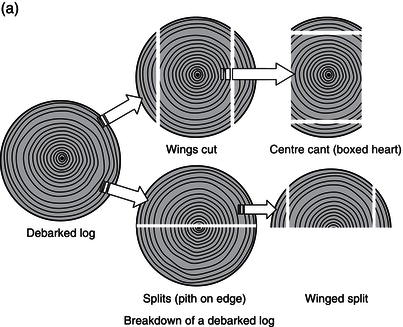
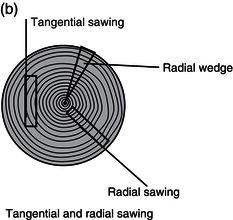
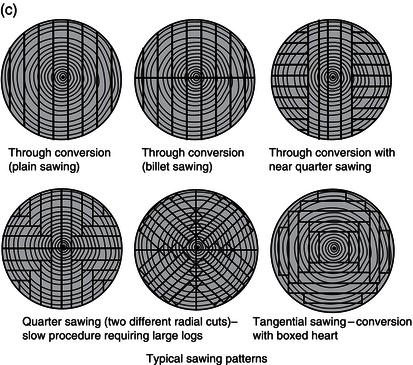
Fig. 1.4. Distortion of various cross-sections [5].
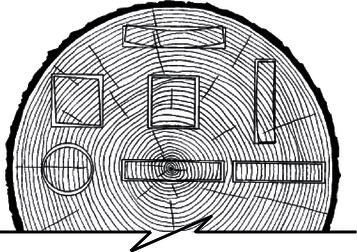
Fig. 1.5. General relationship between strength and/or stiffness and moisture content.
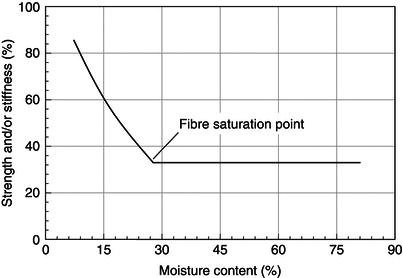
The change in moisture content of timber also affects its strength, stiffness and resistance to decay. Most timber in the United Kingdom is air-dried to a moisture content of between 17 and 23% (which is generally below the fibre saturation point) at which the cell walls are still saturated but moisture is removed from the cell cavities. Figure 1.5 highlights a general relationship between strength and/or stiffness characteristics of timber and its moisture content. The figure shows that there is an almost linear loss in strength and stiffness as moisture content increases to about 27%, corresponding to the fibre saturation point. Further increase in moisture content has no influence on either strength or stiffness. It should be noted that although for most mechanical properties the pattern of change in strength and stiffness characteristics with respect to change in moisture content is similar, the magnitude of change is different from one property to another. It is also to be noted that as the moisture content decreases shrinkage increases. Timber is described as being hygroscopic, which means that it attempts to attain an equilibrium moisture content with its surrounding environment, resulting in a variable moisture content. This should always be considered when using timber, particularly softwoods, which are more susceptible to shrinkage than hardwoods.
Fig. 1.6. Defects in timber.
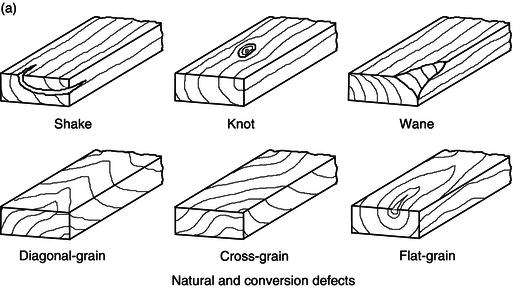
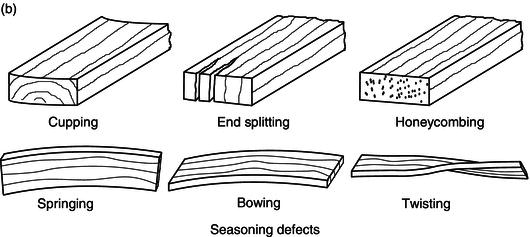
As logs vary in cross-section along their length, usually tapering to one end, a board that is rectangular at one end of its length might not be so at the other end. The rectangular cross-section may intersect with the outside of the log, the wane of the log, and consequently have a rounded edge. The effect of a wane is a reduction in the cross-sectional area resulting in reduced strength properties. A wane is an example of a conversion defect and this, as well as other examples of conversion or natural defects, is shown in Figure 1.6a.
Seasoning is the controlled process of reducing the moisture content of the timber so that it is suitable for the environment and intended use. There are two main methods of seasoning timber in the United Kingdom, air-drying and kiln-drying; other less common methods include solar and microwave techniques. All methods require the timber to be stacked uniformly, separated by spacers of around 25 mm to allow the full circulation of air etc. around the stack. Often, ends of boards are sealed by a suitable sealer or cover to prevent rapid drying out through the end grains. However, with air-drying it is not possible to obtain less than 16–17% moisture content in the United Kingdom. Further seasoning would need to be carried out inside a heated and ventilated building.
The kiln-drying method relies on a controlled environment that uses forced air circulation through large fans or blowers, heating of some form provided by piped steam together with a humidity control system to dry the timber. The amount and duration of air, heat and humidity depend on species, size, quantity, etc.
Seasoning defects are directly related to the movements which occur in timber due to changes in moisture content. Excessive or uneven drying, as well as the presence of compression wood, juvenile wood or even knots, exposure to wind and rain, and poor stacking and spacing during seasoning can all produce defects or distortions in timber. Examples of seasoning defects such as cupping (in tangential cuts), end splitting, springing, bowing, twisting, etc. are illustrated in Figure 1.6. All such defects have an effect on structural strength as well as on fixing, stability, durability and finished appearance.
These are caused by separation of the fibres along the grain forming fissures and cracks that appear on one face or at the end grain but do not necessarily continue through to the other side. Their presence may indicate decay or the beginnings of decay.
This may occur in growing mature timber or even in recently converted timber, and in general it is good practice to reject such timber.
The strength capability of timber is difficult to assess as often there is no control over its quality and growth. The strength of timber is a function of several parameters including the species type, density, size and form of members, moisture content, duration of the applied load and presence of various strength reducing characteristics such as slope of grain, knots, fissures and wane. To overcome this difficulty, the strength grading method of strength classification has been devised. Several design properties are associated with a strength grade; these include modulus of elasticity and bending strength parallel to the grain, strength properties in tension and compression parallel and perpendicular to the grain, shear strength parallel to the grain and density. The design properties of timber are determined non-destructively through visual strength grading criteria or by machine strength grading via measurements such as the following: flatwise bending stiffness, using a three-point or four-point loading system; density, using x-rays or gamma rays techniques; and modulus of elasticity, by means of resonant vibrations (dynamic response) using one or a combination of these methods.
The requirements for strength grading of timber are detailed in the following standards:
Most European Union countries have their own long-established visual grading rules and as such guidance for visual strength grading of softwoods and hardwoods is provided in the following British Standards:
Visual grading is a manual process carried out by an approved grader. The grader examines each piece of timber to check the size and frequency of specific physical characteristics or defects, e.g. knots, slope of grains, rate of growth, wane, resin pockets and distortion.
The required specifications are given in BS 4978 and BS 5756 to determine if a piece of timber is accepted into one of the two visual stress grades or rejected. These are general structural (GS) and special structural (SS) grades. Table 2 of BS 5268-2:2002 [10] (reproduced here as Table 1.2) refers to main softwood combinations of species (available in the United Kingdom) visually graded in accordance with BS 4978.
Machine grading of timber sections is carried out on the principle that stiffness is related to strength; where the relationship between the modulus of elasticity, E, and the modulus of rupture of a species of timber from a certain geographical location is determined from a statistical population, based on a substantial number of laboratory controlled tests. There are a number of ways of determining the modulus of elasticity, including resonant vibration (dynamic response), but the most common methods are either load- or deflection-controlled bending tests. The machine exerts pressure and bending is induced at increments along the timber length. The resulting deflection (or the load to induce a known deflection) is then automatically measured and compared with pre-programmed criteria, which leads to the direct grading of the timber section and marking with the appropriate strength class. An example of the grading marking, based on the requirements of BS EN 14081-1:2005 + A1:2011, is shown in Figure 1.7.
Table 1.2 Softwood combinations of species and visual grades that satisfy the requirements for various strength classes*
| Timber species | Grade and related strength classes |
| British grown timber | |
| Douglas fir | GS (C14), SS (C18) |
| Larch | GS (C16), SS (C24) |
| British pine | GS (C14), SS (C22) |
| British spruce | GS (C14), SS (C18) |
| Imported timber | |
| Parana pine | GS (C16), SS (C24) |
| Caribbean pitch pine | GS (C18), SS (C27) |
| Redwood | GS (C16), SS (C24) |
| Whitewood | GS (C16), SS (C24) |
| Western red cedar | GS (C14), SS (C18) |
| Douglas fir-larch (Canada and USA) | GS (C16), SS (C24) |
| Hem-fir (Canada and USA) | GS (C16), SS (C24) |
| Spruce-pine-fir (Canada and USA) | GS (C16), SS (C24) |
| Sitka spruce (Canada) | GS (C14), SS (C18) |
| Western white woods (USA) | GS (C14), SS (C18) |
| Southern pine (USA) | GS (C18), SS (C24) |
*Timber graded in accordance with BS 4978:1996; based on Table 1.2, BS 5268-2:2002.
Fig. 1.7. Example of simplified grading marking.

In general less material is rejected if machine graded; however, timber is also visually inspected during machine grading to ensure that major, strength-reducing, defects do not exist.
Table 1.3 Strength and stiffness properties and density values for structural timber strength classes, (in accordance with Table 1, of BS EN 338: 2009)
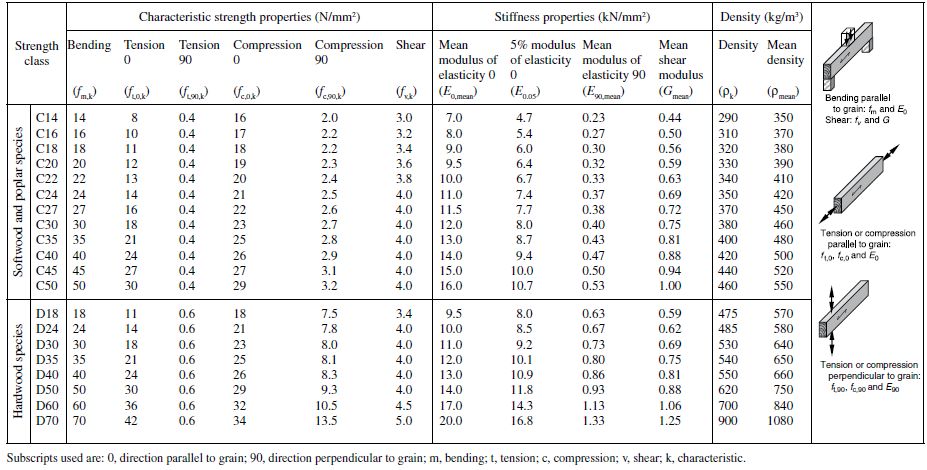
The concept of grouping timber into strength classes was introduced into the United Kingdom with BS 5268-2 in 1984. Strength classes offer a number of advantages both to the designer and the supplier of timber. The designer can undertake the design without the need to check on the availability and price of a large number of species and grades that might be used. Suppliers can supply any of the species/grade combinations that meet the strength class called for in a specification. The concept also allows new species to be introduced to the market without affecting existing specifications for timber.
BS EN 338:2009 [11] defines a total of 20 strength classes: 12 for softwoods – C14, C16, C18, C20, C22, C24, C27, C30, C35, C40, C45 and C50; and 8 for hardwoods – D18, D24, D30, D35, D40, D50, D60 and D70. The letters C and D refer to coniferous species (C classes) or deciduous species (D classes), and the number in each strength class refers to its ‘characteristic bending strength’ in N/mm2 units; for example, C40 timber has a characteristic bending strength of 40 N/mm2. It ranges from the weakest grade of softwood, C14, to the highest grade of hardwood, D70, often used in Europe.
Section 3 of BS EN 1995-1-1:2004 + A1:2008 (referred to in the text as EC5) [12] deals with the material properties and defines the strength and stiffness parameters, stress–strain relations and gives values for modification factors for strength and deformation under various service classes and/or load duration classes. EC5, in common with other Eurocodes, does not contain the material property values and this information is given in a supporting standard, i.e. in Table 1 of BS EN 338:2009, reproduced here as Table 1.3.
The characteristic values are defined as the population 5th-percentile values obtained from the results of tests with a duration of approximately 5 min at the equilibrium moisture content of the test pieces relating to a temperature of 20 °C and a relative humidity of 65%.
In addition to providing characteristic strength and stiffness properties and density values for each strength class (and the rules for allocation of timber populations, i.e. combinations of species, source and grade, to the classes), BS EN 338:2009 lists the equations that form the relations between some of the characteristic values given in Table 1.3 for properties other than bending strength, mean modulus of elasticity in bending and density.
The relationships between the characteristic strength and stiffness properties are given as follows:
In general, it is possible to design timber structures using any size of timber. However, since the specific use is normally not known at the time of conversion, sawmills tend to produce a range of standard sizes known as ‘common target’ sizes. Specifying such common target sizes will often result in greater availability and savings in cost.
There are a number of alternative sizes and finishes of cross-sections. BS EN 1313:2010 [13] specifies permitted deviations for thickness and width at reference moisture content of 20% and adjustments for changes in section sizes due to change in moisture content. The deviation in sawn sections at a moisture content of 20% are as follows: for thicknesses and widths up to 100 mm, –1 mm and +3 mm, and for over 100 mm sizes, –2 mm and +4 mm. Sawn sections should only be used in situations where dimensional tolerances are of no significance. Planing two parallel edges to a specified dimension is referred to as regularising and if all four edges are planed to specified sizes, the process is referred to as planed all round. The requirements of EC5 for timber target sizes (i.e. specified sizes) are those given in BS EN 336:2003 [14] and in its National Annex. This standard specifies two tolerance classes: tolerance class 1 (T1) is applicable to sawn surfaces, and tolerance class 2 (T2) applicable to planed timber. Regularised timber can be achieved by specifying T1 for the thickness and T2 for the width. For T1, dimensions of up to 100 mm are limited to –1/+3 mm and dimensions of over 100 mm to –2/+4 mm. For T2, dimensions of up to 100 mm are limited to –1/+1 mm and those over 100 mm to –1.5/+1.5 mm.
The commonly available lengths and cross-section sizes are also listed in the UK National Annex of BS EN 336, and are referred to as target sizes. The ‘target size’ is defined as the specified timber section size at a reference moisture content of 20%, and to which the deviations, which would ideally be zero, are to be related. The target sizes can be used, without further modification, in design calculations.
The common target sizes, whose sizes and tolerances comply with BS EN 336, for sawn softwood structural timber, for structural timber machined on the width and for structural timber machined on all four sides are given in Table 1.4. In Table 1.5 the range of lengths of sawn softwood structural timber are detailed.
The readily available sawn sections of softwood are limited in size and quality. The largest section sizes available are 75 mm thick × 225 mm wide and at most 5 m in length. Any larger section sizes would suffer from both conversion and seasoning defects. EWPs are developed to overcome the limitations of sawn timber and are produced, in combination with adhesives, in a variety of forms: